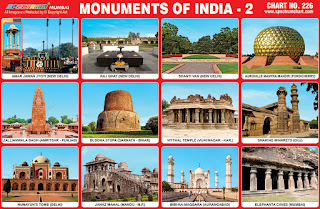Amar Jawan Jyoti (New Delhi)
- Amar Jawan Jyoti or the flame of the immortal soldier, is a
structure consisting of black marble plinth, with a rifle, capped by
war helmet, bound by four urns, each with the permanent light
(jyoti) erected under the India Gate in the wake Liberation of
Bangladesh in December 1971 to commemorate Indian soldiers killed in
the defence of their country.
Raj Ghat (New Delhi) - Raj
Ghat is a memorial to Mahatma Gandhi. It is a black marble platform
that marks the spot of Mahatma Gandhi's cremation,(Antim Sanskar) on
31 January 1948.
Shanti Van (New Delhi) -
Jawaharlal Nehru's samadhi is known as the Shantivan or Shanti Van
meaning the "forest of peace". It is located in the same
premises of Raj Ghat.
Auroville Mantri Mandir
(Puducherry) – Matrimandir is an edifice of spiritual
significance for practitioners of Integral yoga, situated at the
centre of Auroville. Matrimandir took
37 years to be built. It was completed in 2008.
Jallianwala Baug (Amritsar)
- Jallianwala Bagh is a public garden in Amritsar and houses a
memorial of national importance, established in 1951 to commemorate
the massacre of peaceful celebrators including unarmed women and
children by British forces, on the occasion of the Punjabi New Year
on April 13, 1919 in the Jallianwala Bagh.
Dhamek Stupa (Sarnath) -
Dhamek Stupa is a massive stupa located at Sarnath. Dhamek Stupa is
said to mark the spot of a deer park where the Buddha gave the first
sermon to his five disciples after attaining enlightenment.The
Dhamek Stupa was built in 500 CE to replace an earlier structure
commissioned by the great Mauryan king Ashoka in 249 BCE, along with
several other monuments, to commemorate the Buddha's activities in
this location.
Vittala
Temple (Vijaynagar) - Vittala Temple is dedicated to Vittala, an
aspect of Vishnu worshipped in the Maratha country. One of the
notable features of the Vittala Temple is the musical pillars. These
pillars, when struck, emanate the 7 notes from the representative
instrument, varying in sound quality based on whether it represents
a wind, string or percussion instrument.
Shaking Minarets (Gujarat)
- Sidi Bashir Mosque was located in the city of Ahmedabad, Gujarat.
Due to its unique construction, the minarates of mosque are also
called Jhulta Minar or Shaking Minarets. The mosque was completed in
1452.
Humanyun's Tomb (Delhi) -
Humayun's tomb is the tomb of the Mughal Emperor Humayun in Delhi.
The tomb was commissioned by Humayun's son Akbar in 1569-70.
The tomb was declared a UNESCO World Heritage Site in 1993.
Jahaz Mahal (Mandu) - Jahaz
Mahal is one of the most beautiful fort in Mandu places. The Jahaz
Mahal or the Ship Palace was built in the 15th century. This palace
was built between two beautiful lakes, Kapur Talao and Munj Talao,
to make it appear like a floating ship. When these two lakes are
full of water then Jahaz Mahal looks like a ship, standing on a sea.
Bibi Ka Maqbara (Aurangabad) -
Bibi Ka Maqbara is a maqbara located in Aurangabad, It was built by
Azam Shah, son of Aurangzeb, in 1678 in memory of his mother, Dilras
Banu Begum. It bears a striking resemblance to the famous Taj Mahal.
Elephanta Caves (Mumbai) –
The Elephanta Caves are a network of sculpted caves located on
Elephanta Island, or Gharapuri in Mumbai Harbour.The Hindu caves
contain rock cut stone sculptures, dedicated to the Lord Shiva.
Elephanta caves were declared as UNESCO
World Heritage Site in 1987.


No comments:
Post a Comment